By Mabel Plaskett
The Coast Trail series would not be complete without the story of Margaret Krenkel who came to Los Burros in much the same circumstances as the pictorial “Hannah” of Lillian Bos Ross’s novel “The Stranger” for Margaret Voss Schmidt who was city born and bred, came to love the coastal mountains as no other has ever loved them.
Margaret Krenkel was of German parentage, her father was Carsten Voss born in Hamburg, Germany, and came to San Francisco in 1860 n a sailing vessel and opened a lunch counter later going into the hotel business.
Her mother Charlotte Schlicting, was born in Altoona, Germany and was a nurse for an English family who took her to their home in England where she lived for 12 years. She came to San Francisco in 1870 and stopped at Carsten Voss’ hotel.
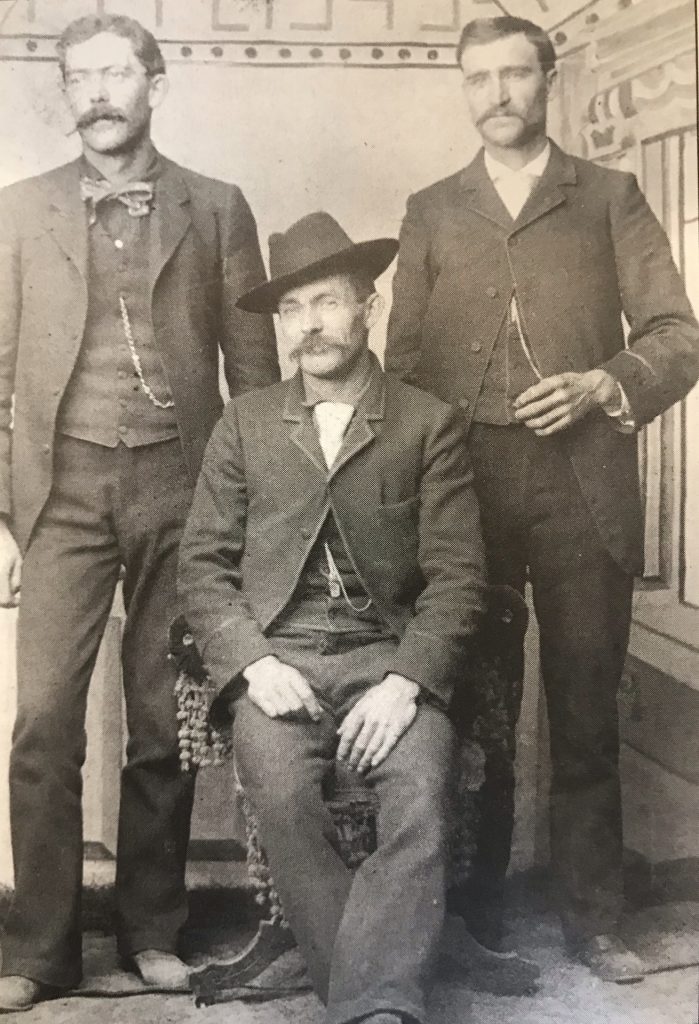
Stan Hill, W.D. Cruikshank and James Munroe Krenkel c. 1890 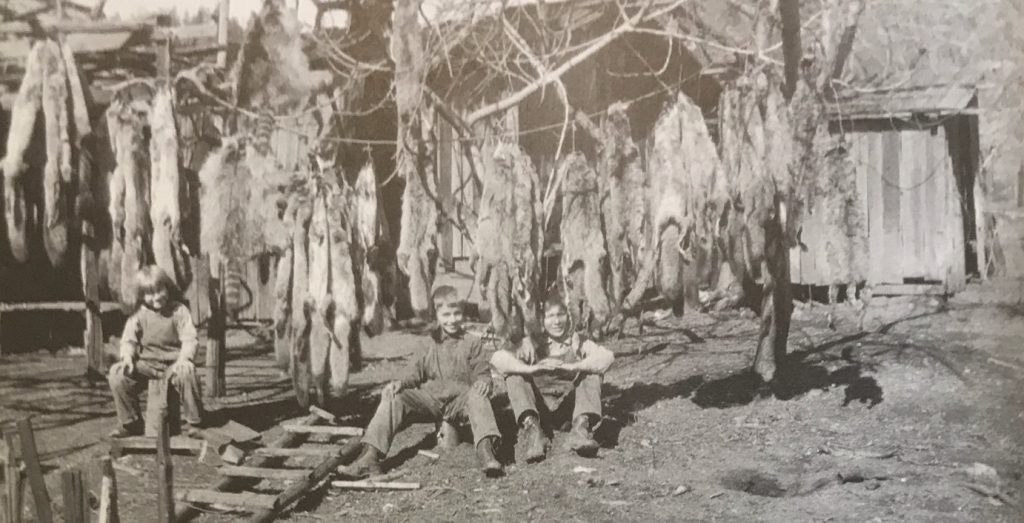
Krenkel Ranch Animal Fur Trapping c. 1926 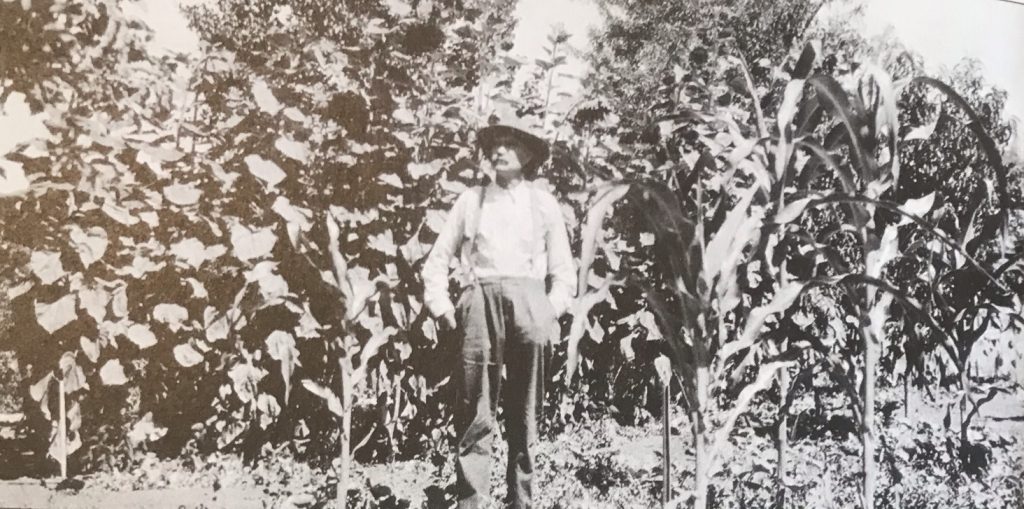
James M. Krenkel at garden above Alder Creek in Los Burros Mining District c. 1930 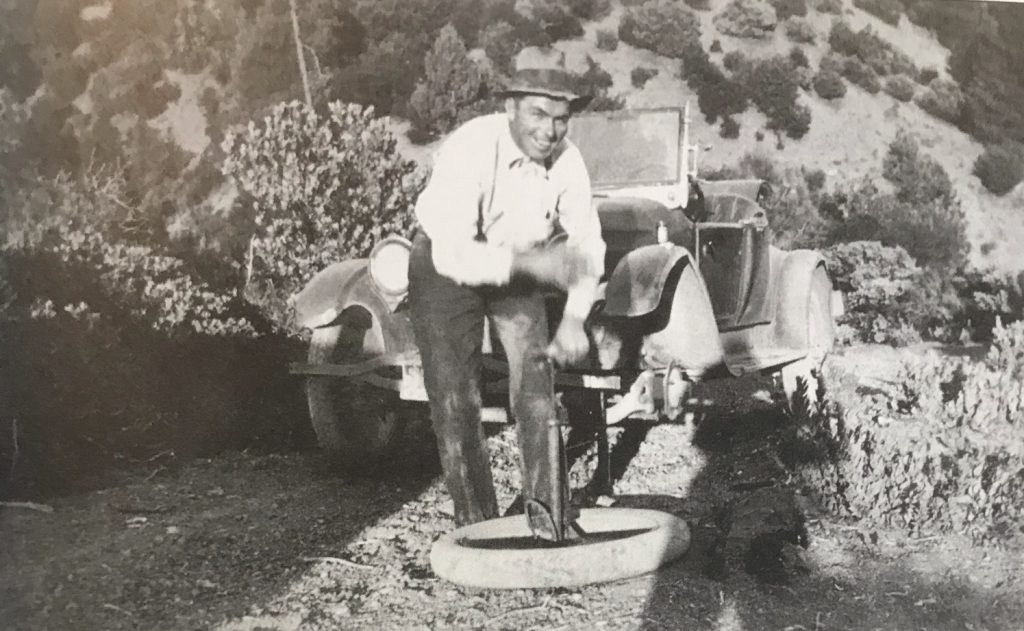
Charlie Krenkel changing a tire c. 1930 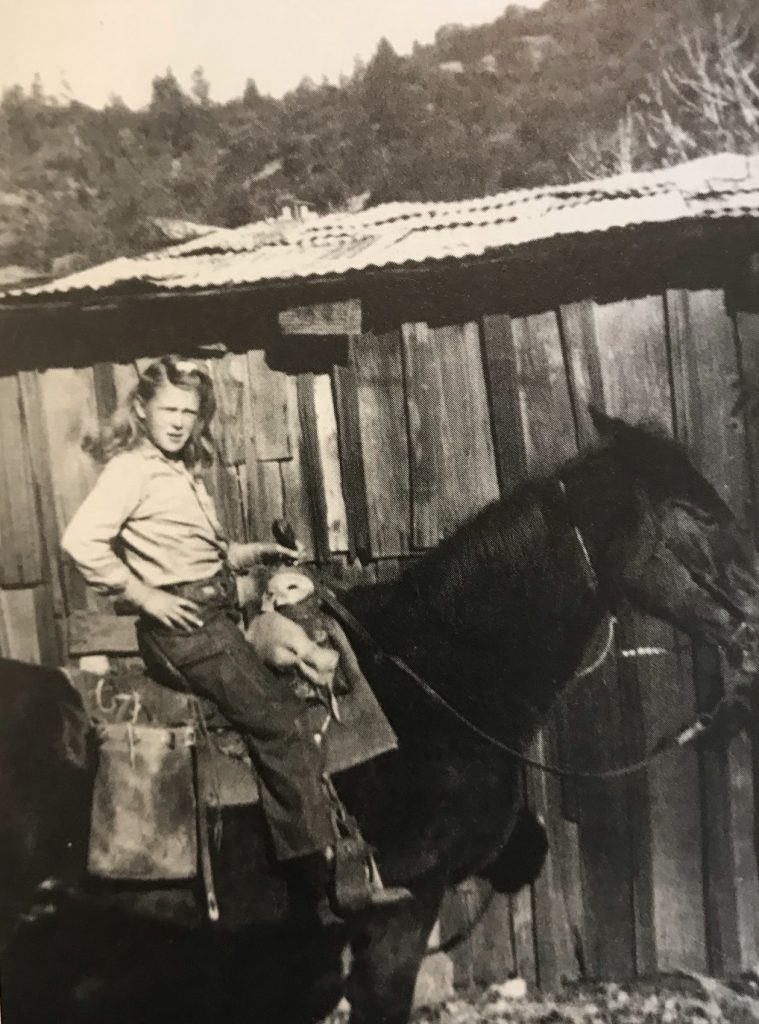
Shirley Whitney Krenkel
Mother Krenkel: A Coast Legend
Carsten was now a widower with three small children. A friendship developed between them, fostered no doubt by Charlotte Schlicting’s great love for children and seeing the need of a mother in the family agreed to marry Mr. Voss. They were married in 1872 and four children were born to them, Margaret or “Greta”, Charlotte (always called Lottie), Charley and Mary. Margaret laughingly tells of being born in a house among the sand dunes near the “Barbary Coast.”
About this time Will Voss developed a lung ailment and moved to San Ardo. When Charley became ill the elder Voss decided to come to Monterey County for the health of their son so they came to Pleyto and settled on a homestead between Pleyto and Lockwood near the Ferguson Place and over the hill from the Frank Cox place.
Lottie married Charley Ferguson and after his death in later years married Frank Cox. They still live on the old Cox home on the Pleyto road.
Margaret Schmidt, with little Margery, made her home with her parents on the ranch. She and Lottie helped dig the well for the first 50 feet. After that a Mr. Pauling took over the well digging job and one day he passed [illegible] well. They got him out and after he revived he insisted in going down again and again he was overcome by gas fumes.
A NEIGHBOR named Mr. Suits, a carpenter who had helped build Voss’ house, was called to help get Paul out. He was let down by a rope and while trying to get a hold on the man he was also overcome by gas and fell across Paulings body. By the time more help came to get both men out with rose and windlass they were both dead.
This well was then abandoned and another one dug without mishap. It was 160 feet to water. While waiting for a well to be dug on the property all water for household use was hauled from the Cox ranch which was just south of the Voss place.
When Margaret arrived in Bradley on her first visit to her family she was met by a stage driver name Volkerts. She rode in a buck board to the ranch in icy weather, it being winter. The stage ran between Bradley and Pleyto. At that time there was a blacksmith shop, Gimbals Store, a branch of Gimbals store at Bradley, and the Pleyto Hotel.
WHILE LIVING at the home of her parents on the Pleyto road Margaret worked for many of the neighbors. During harvest time she cooked for the crew getting up at an early hour and working until late at night. At that time the settlers had only the crudest facilities. Her wages were $10 a month.
She was often called to a home in cases of illness and became a capable practical nurse.
Among the early families Margaret worked for were the Nace family, Lisks, Johansense, McDonoughs, Heinsens, Moros, Williamsons, Pinkertons, Pattersons, Macavoys, Mrs. Winters and many others.
She also worked at the Pleyto Hotel for a time, but she preferred to work in private homes as it seemed to her more suitable, and no doubt the attractive young [illegible] object of many a man’s admiring glance. She, however, paid scant attention to the country swains being a serious minded young woman intent on doing her work well.
While she was working for the Heinsen family a miner of Los Burros named Jim Krenkel called at the home. Thinking he came as a friend of the family she paid little attention until one evening the lady of the house said, “Greta, Mr. Krenkel comes to call on you and I think you should walk to the gate with him.” She did so and was astonished to hear him make an offer of marriage. She stammered in a confused manner that she would have to have time to think.
SO HE SAID, “Very well, until you are ready to decide, I will wait.”
Time and change went by until Mr. Krenkel suggested that Greta take a trip to his Los Burros home and make her final decision. To this she agreed and in 1901 a party consisting of Mr. and Mrs. Lair Patterson, Mr. and Mrs. Frank Patterson with their two sons, Charley and Floyd, and Greta made the trip. They rode over the Old Mail Trail through cool canyons over chapparal covered ridges under groves of majestic pines to the coast side where they looked down to see the vast blue Pacific spread out before them.
When they reached the Krenkel home, about two miles off the main trail Jim was there to greet them. Greta looked about her at the neat well-made cabin, the orchard and vineyard, and flowers about the house and she liked what she saw. That very evening she told Him she loved the place and the answer was yes.
So it was in June 23, 1902 they were married in San Luis Obispo, with Rev. Clague officiating. A shivaree was given them that night at Mrs. Ferguson’s, and another a few evenings later at Mrs. Lair Patterson’s which all of Lockwood attended.
After all these festivities they took the trail to the Coast, Greta riding a trusty black mule named “Gabe.”
THIS WAS a different life than Greta had ever known and she was determined to make a success of this venture. She was kept busy working in house and garden, often cooling for men working at the Buclimo Mine which was one of the few mines still operating.
The “Buclimo” was named for the seven partners who formed a corporation after buying the mine from Kim Krenkel and Billy Cruikshank in 1887. The names of the seven forming the corporation were Burman, Ulrich, Clinton, Linderman, Isenman, Morey and Olsen. Using the initials of these names, The Buclimo Corporation was formed.
Jim Krenkel worked for the Buclimo Company off and on and has worked his own claims, the “Protection” and “The Oregon.” These claims, with the Krenkel home on them are still in the family.
AS EARLY as 1875 mines were worked in the Los Burros. Chinese placer miners operated in Salmon Creek even before that. The first records were kept by Will Cruikshank, Sr. and are dated 1875. Later Judge Gag, who with his wife and two children lived in Los Burros kept the records. It was he who build the Krenkel house and sold out to Jim Krenkel. From then on Jim Krenkel kept the mining records. He was the official district recorder.
The fee was 50c for recording claims and assessment work. At that time the work was done from Jan 1. To Jan. 1. Later it was between July 1 to the following July 1st. Miners living near the Krenkels were Ramon Simos, an Indian, Clay Dodge, Billy Cruikshank and others. When first established the boundaries of Los Burros Mining District reached from Plaskett Ridge to San Corpolo.
When Mrs. Krenkel came to Los Burros it was already a ghost town. Of the 13 saloons only one remained, run by Pete Gillis in a two story framehouse with the saloon and living quarters on the ground floor and a dance hall in the upper. People came from as [illegible] occasional fiestas.
WATER WAS plentiful, coming from a cool deep spring in the very mouth of the Last Chance tunnel. It was carried to the house in V-troughs made from pine saplings. Fruits and grapes were canned for winter use and the family fared well. Any sense of loneliness was dispelled by the companionship of the children so dear to her heart.
One of the highlights was the early arrival of a stout Assyrian peddler coming down the trail nearly hidden by his load looking like burro all packed. He carried an assortment of household wares, linens and tapestries fringed and fancy, ill-suited to simple mountain living. Mother Krenkel always bought each boy a pocket knife which delighted their young hearts.
Eight children came to the Krenkels as follows: Bill, Jim, Charley, Doreen, Hally, Howard, Dorothy and Lillian, Margery, who also went by the name of Krenkel, was a great help to her mother. The children attended Pacific Valley school. Mrs. Krenkel lived in Pacific Valley for a few years in order to send them to school. It was during this time little Dorothy, aged 10 months, became ill and within a few days died of pneumonia and was buried in the little cemetery by the road beside little Harry Mansfield. This was a sad time and Mother Krenkel grieved until Lillian her last child was laid in her arms. It was at this time she composed a poem to Lillian.
“When sunset merged its shadings with the night.
You came to me a tiny helpless mite
To cuddle close and give to me again
The peace and joy that follows after pain.”
Soon after Lillian’s birth the family moved back to the home in Los Burros, and a part time school was established. The guest room was used as a school room, part of it partitioned off for the teacher’s lodging.
Miss Jessie Anderson was the first teacher for this mountain school dividing her time between Krenkels and Pacific Valley, teaching one week at each school.
FOR A TIME there was only one pupil at Pacific Valley, Elton Mansfield. Miss Anderson rode horseback all the way from Salinas to the mountains. Later when Mrs. Wimmer with her daughter Velma came to teach the time was changed to 4 1/3 months at each school. Still later a full time school was maintained at Los Burros. During these years Miss Susan Bird, Mrs. Lawhead and Mrs. White taught the Krenkel children.
While the coast highway was under construction Mrs. Krenkel ran a boarding house in San Simeon for road workers. Then she lived in Cambria for one year This was while Lillian was attending high school. These were but sojourns from her beloved mountain home to which she returned when the children were through school. At the completion of the coast road in 1937 Mrs. Krenkel was asked to contribute something to be given at the ceremony at Lime Kiln where the ribbons were cut and the final link of the coast highway officially opened.
She composed these lines:
Plodding along with meet burros,
Fast stepping when horses felt gay
They enjoyed the lone life in the fastness
Pioneers of the old yesterday.
To them the coast trail was a heritage
Left by Indians who lie
In the sod of the Santa Lucia’s
While our life of the world rushes by.
This trail was the Indian’s glory
Prized by the whites when they came.
To nest in the fold of the mountains
To breathe of adventure and romance
Every minute of its long winding way.
Linking bright scenes of San Simeon
With the New and the Old Monterey
Although it was rugged and tiresome
Its path so chopping and worn
It served a great purpose to mankind
Before the new highway was born.
Now grim pioneers seem bewildered
As the joys of the past start to pale.
In the glamour of auto and highway
That surpasses the old Coast Trail.
THESE WORDS were ready to a great gathering at the ceremonies attended by Gov. Merriam and Dr. Roberts of Monterey, one of the early champions of the new road. Sadly enough Senator Elmer Rigdon, whose early dream and constant effort helped materialize the project, did not live to witness its completion. However, great credit is given him and a plaque in his honor was erected between Big Creek and Gamboa Point.
It was in the year 1937 that a great tragedy occurred. Young Jim was shot by a neighboring miner, Ernest Bauman, a Russian who had come to the mountains in 1909 to work for Mrs. Reed, owner of the Gorda Mine. Later on he filed on a claim near the Lonny Plaskett place building a cabin of logs which he carried on his back from some distance.
He was a large man of Herculean strength. He had an altercation with Mrs. Krenkel, not long after coming to the mountains on account of paying marked attention to Margery a very young girl at the time. Having been told to stay away from the girl, there had been strained relations between them, but Mother Krenkel told her sons to treat him civilly whenever they met.
HOWEVER, Mr. Bauman was a strange man with an obsession of being persecuted, and became angry when his gate was left open or his premises entered. On this fatal night a mining engineer was driving past and suddenly all of his tires went flat. He walked to young Jim Krenkel’s house near by the elder Krenkels and asked him to bring a flashlight to see about the car. They found large spikes planted in the road. Jim said, “Bauman has done this, we must talk to him.”
So they started toward his place. Hearing a movement in the nearby bushes young Krenkel called, “Come out Bauman, we want to talk to you.”
Instead of coming Bauman fired, hitting Him. He was taken to Cambria to the doctor, but died next day at the age of 32. He is buried at Cambria.
Strangely enough Bauman was set free at the ensuing trial, but he never returned to the mountains. His lawyer got his place and many years later Ernest Bauman met his death in a deep mining tunnel in the lonely mountains of Northern California.
SO TIME passed until Mr. Krenkel died of a heart attack in 1943 at the age of 81. He was buried in King City.
Mother Krenkel returned to live in her mountain home, enjoying visits from her children.
Margery died a few years ago, but all the others came when they could, and Doreen lived close by. She kept her strength and indomitable spirit until in 1959 she suffered a stroke and was taken to the hospital. She rallied and spent some time again at her old home, but a recurring attack took her again to the hospital and she agreed then to make her home among her family.
Most of the time she is with her son Hal, who, with his wife Mary and daughters Margaret and Nancy, make her welcome at their home in Jolon.
Bill, her eldest, lives nearby and she often visits on the coast at Gorda with Howard (Tuck) and wife Jackie and daughters, Cindy and Dorothy. Also with son Charley and wife Robbie who live in Cambria with their children. Lillian married Colonel Maxwell, a retired Air Force man, and lives in Redwood City. Doreen first married a man named Whitney and later married Frank Digges, who is now dead. Her daughter, Shirley Whitney, is now Mrs. Don Moore and lives in Atascadero, with her two children. She loves the coast and often visits at the old home in Los Burros. Bill has a girl Sally, now married and boy Billy who is in the U.S. Air Force.
MOTHER KRENKEL, as she is called by all who knew her, is still enjoying life, her remarkable mind as alert as ever. She lives serenely her philosophy of life keeping her happy as long as panorama of events pass through her mind, she lives again the happy years of her life in Los Burros under the giant Coulter pines with the blue mountains crowned by Cone Peak in the distance.
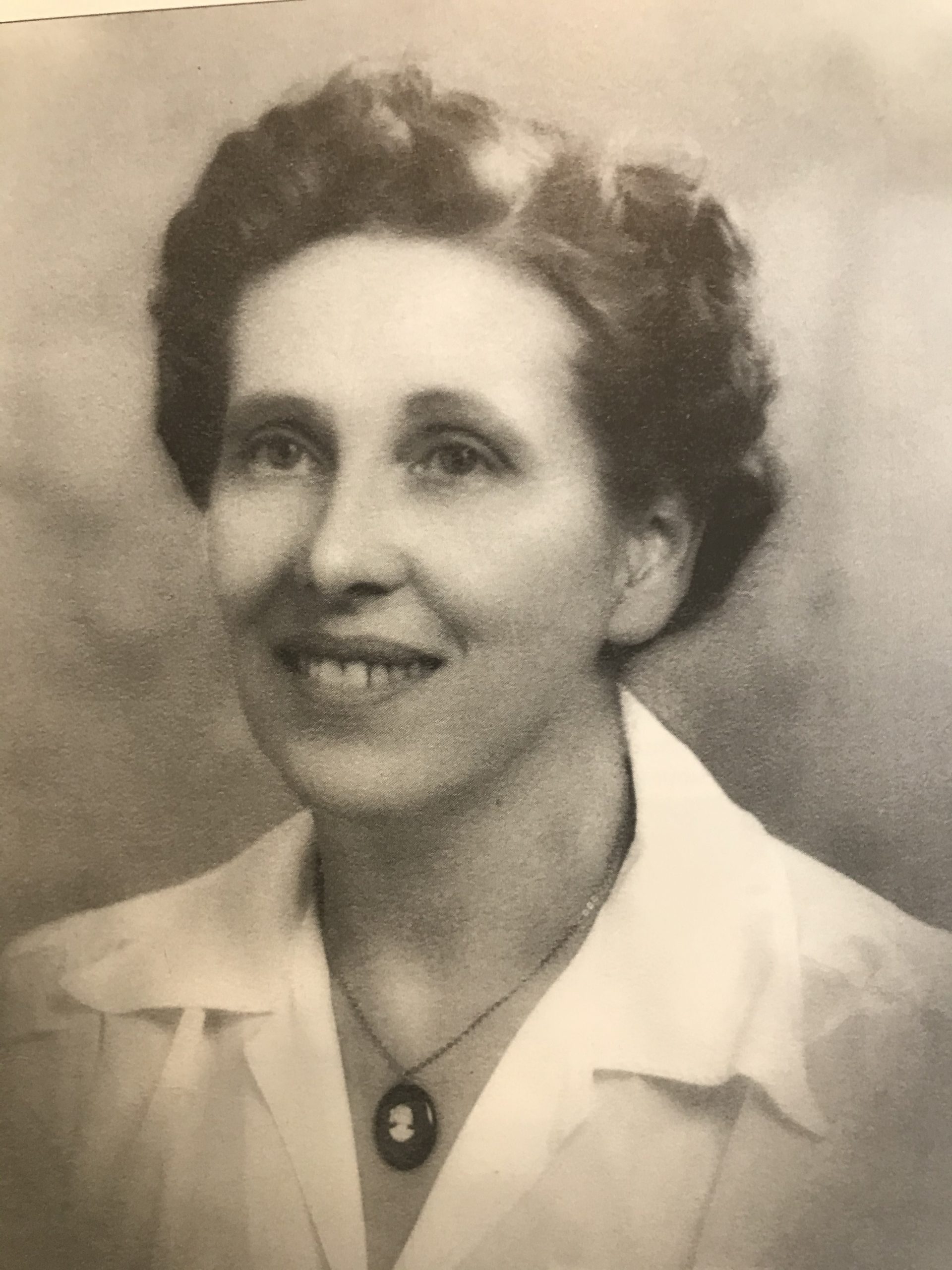
Mabel Sans Plaskett was born in Coralitas near Ben Lomond in the Santa Cruz Mountain area of California. Her father Edward Robert Sans ran a saw mill near Pacific Valley, along the Nacimiento – Ferguson road to the coast at Highway One. It was there she met Edward Abbott Plaskett, her husband. Mabel wrote about the coast and the pioneers of the 19th and 20th Centuries.
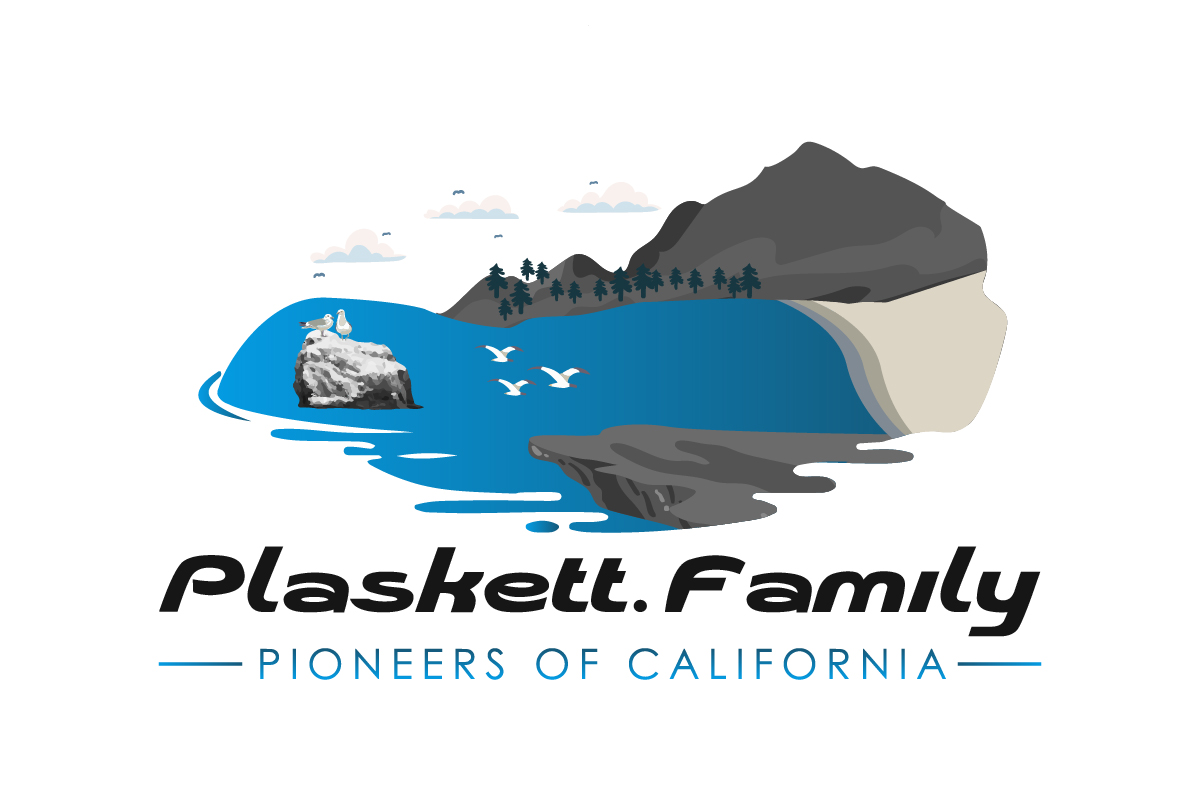
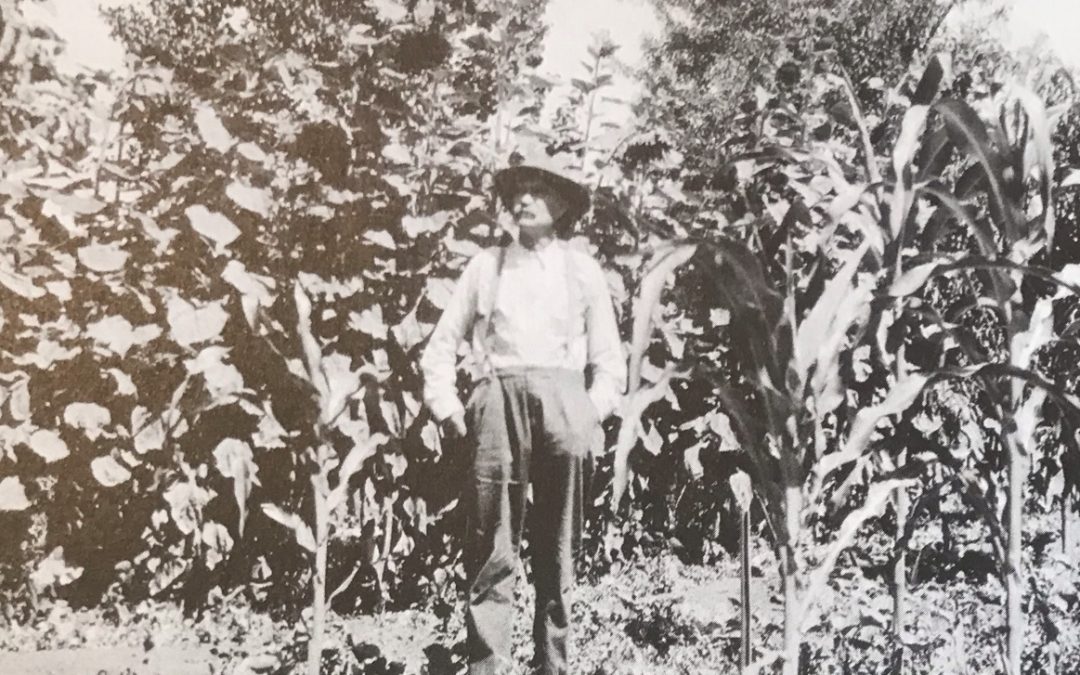
Recent Comments